Consider the function:
![]()
where the independent variable x ranges between 0 and X, and the exponents are large: ![]() . [We could call it a “polynomial”, though the exponents need not be integers. Specifically it is the product of “monomials” in x and X – x, so might possibly be called a “sparse” polynomial in this sense.] Surprisingly, it closely resembles a gaussian curve, over our specified domain
. [We could call it a “polynomial”, though the exponents need not be integers. Specifically it is the product of “monomials” in x and X – x, so might possibly be called a “sparse” polynomial in this sense.] Surprisingly, it closely resembles a gaussian curve, over our specified domain ![]() .
.

 , and for each non-integer exponent the tail on one side becomes imaginary.
, and for each non-integer exponent the tail on one side becomes imaginary.The turning point is where the derivative equals zero. This occurs when x is the surprisingly simple expression:
![Rendered by QuickLaTeX.com \[\tilde x := \frac{X}{1+B/A},\]](http://cmaclaurin.com/cosmos/wp-content/ql-cache/quicklatex.com-63503dd0564d1a52ac96d3a1640448a1_l3.png)
at which the function has value:
![]()
An arbitrary gaussian, not necessarily normalised, has form: ![]() . This has centre D which we equate with
. This has centre D which we equate with ![]() , and maximum height C which we set to the above expression. We can fix the final parameter, the standard deviation, by matching the second derivatives at the turning point. Hence the variance is:
, and maximum height C which we set to the above expression. We can fix the final parameter, the standard deviation, by matching the second derivatives at the turning point. Hence the variance is:
![Rendered by QuickLaTeX.com \[\sigma^2 = \frac{AB}{(A+B)^3}X^2 \equiv \frac{B}{A^2X}\tilde x^3.\]](http://cmaclaurin.com/cosmos/wp-content/ql-cache/quicklatex.com-a9b3e559a77aa85b702f021ab451ce4b_l3.png)
Hence our gaussian approximation may be expressed:
![Rendered by QuickLaTeX.com \[\boxed{(B/A)^B \tilde x^{A+B} \operatorname{exp}\Big( -\frac{(x-\tilde x)^2}{2B\tilde x^3/A^2X} \Big).}\]](http://cmaclaurin.com/cosmos/wp-content/ql-cache/quicklatex.com-231edb19ae54a811f95077fe10c1f232_l3.png)
The integral of the original curve turns out to be:
![Rendered by QuickLaTeX.com \[\int_0^X x^A(X-x)^Bdx = \frac{X^{A+B+1}}{(A+B+1)\binom{A+B}{A}}.\]](http://cmaclaurin.com/cosmos/wp-content/ql-cache/quicklatex.com-62f1b0ae17cb0881a5e0f7f01c59ce05_l3.png)
This uses the binomial coefficient ![]() , which is extended to non-integer values by replacing the factorials with Gamma functions. We could then apply Stirling’s approximation
, which is extended to non-integer values by replacing the factorials with Gamma functions. We could then apply Stirling’s approximation ![]() to each factorial, to obtain:
to each factorial, to obtain:
![Rendered by QuickLaTeX.com \[\int\cdots \approx \frac{\sqrt{2\pi(A+B)}}{A+B+1}(B/A)^{B+1/2}\tilde x^{A+B+1},\]](http://cmaclaurin.com/cosmos/wp-content/ql-cache/quicklatex.com-8e45ac6bded4d3733a9f18fd0fe8b6d3_l3.png)
though this is more messy to write out. On the other hand, the integral of the gaussian approximation is:
![Rendered by QuickLaTeX.com \[\int_{-\infty}^\infty \operatorname{exp}\cdots = \sqrt\frac{2\pi}{A+B}(B/A)^{B+1/2}\tilde x^{A+B+1}.\]](http://cmaclaurin.com/cosmos/wp-content/ql-cache/quicklatex.com-6a1d3bd57315c5c72453e2f129c53372_l3.png)
We evaluated this integral over all real numbers, because the expression is simpler and still approximately the same. The ratio of the above two expressions is ![]() .
.